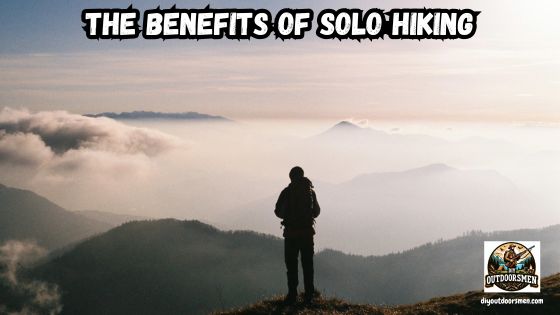Contents
- 1 The Upside of Going Solo and What Makes Solo Hiking Appealing
- 2 Getting Started with Solo Hiking the Practical Steps and Mindset
- 3 Planning Your Solo Adventure with Tips for Success and Enjoyment
- 4 Dealing With Challenges, Safety, and Solo Hiking Hazards
- 5 Taking It Up a Notch with Advanced Tips for Solo Hiking and Backpacking
- 6 RealWorld Examples of What Solo Hikers Experience
- 7 Frequently Asked Questions on Solo Hiking
- 8 Wrapping Up on Solo Hiking
Solo hiking offers a unique path for anyone looking for peace, a greater sense of independence, and a more personal connection to nature. When I hike alone, I get to choose my pace, stop wherever I want, and notice my surroundings.
QUICK LOOK: Benefits of Solo Hiking
Independence: Hiking alone teaches me to rely on my decisions and skills. I become more confident as I solve challenges like finding the trail, handling gear problems, or reading the weather.
Peace and Solitude: Sometimes, I notice little details I’d never spot when I’m with a group, like the sound of birds, the rustle of leaves, or the shifting colors at sunset. Without conversation, I connect more deeply with the environment.
Flexible Schedule: Some days I want to move quickly and cover a lot of ground. Other times, stopping by a creek or lingering at a scenic viewpoint just feels right. Hiking solo gives me complete freedom over every decision, which I find incredibly refreshing.
Personal Challenge: Each solo hike pushes me to grow. Whether I’m managing navigation, carrying a heavier pack, or camping alone overnight, every challenge makes the next trip feel more doable.
Stepping onto the trail without a group might feel intimidating at first, but with good preparation, the rewards more than make up for the nerves. I’m going to break down the key benefits of solo hiking, share tips for getting started, help you plan and stay safe, and answer a few common questions I hear from other hikers.
The Upside of Going Solo and What Makes Solo Hiking Appealing
Solo hiking is about more than being by myself. It gives me a rare chance to enjoy long stretches of quiet and think clearly while surrounded by nature. Here are some things I really appreciate about solo trips on the trail:
- Independence: Hiking alone teaches me to rely on my decisions and skills. I become more confident as I solve challenges like finding the trail, handling gear problems, or reading the weather.
- Peace and Solitude: Sometimes, I notice little details I’d never spot when I’m with a group, like the sound of birds, the rustle of leaves, or the shifting colors at sunset. Without conversation, I connect more deeply with the environment.
- Flexible Schedule: Some days I want to move quickly and cover a lot of ground. Other times, stopping by a creek or lingering at a scenic viewpoint just feels right. Hiking solo gives me complete freedom over every decision, which I find incredibly refreshing.
- Personal Challenge: Each solo hike pushes me to grow. Whether I’m managing navigation, carrying a heavier pack, or camping alone overnight, every challenge makes the next trip feel more doable.
These aspects combine to make solo hiking one of my favorite ways to learn, look inward, and completely unwind.
Getting Started with Solo Hiking the Practical Steps and Mindset
When I first considered hiking alone, breaking down the preparation into steps made the process simple and less stressful. Here’s what helped me most as I took those first solo walks in the woods:
- Start Small: My initial solo hikes were short and on clearly marked trails. Gradually, as my confidence grew, I added distance and sought out slightly more challenging paths.
- Know the Area: I always pick routes I’ve hiked before or that are popular among other hikers. Familiarity with the landscape helps me feel safer, especially on my own.
- Check the Weather: Good weather can make a huge difference for a solo outing. I avoid trails during extreme heat, storms, or high winds until I have more experience and the right gear.
- Learn Map and Compass Skills: Even with a phone loaded with maps, I keep a paper map and compass as backup. Practicing with these helps me avoid relying only on technology.
Following these guidelines helped me move from quick day hikes to more adventurous solo trips with greater confidence and a stronger safety net.
Planning Your Solo Adventure with Tips for Success and Enjoyment
Every solo hike benefits from thorough planning and the right attitude. Here are some things I do before heading out on my own:
- Check Your Route: I always check trail reports, study recent maps, and do a quick search for any wildlife or environmental warnings in the area. Knowing about water sources and possible hazards helps me avoid surprises.
- Packing Smart: My essentials include a map, compass, first-aid kit, extra food and water, headlamp, portable phone charger, layers to stay warm, and a rain jacket. For longer trips, I add a sleeping bag, a tent, and water purification tools.
- Share Your Plans: Before heading out, I let a friend or family member know my route and when I plan to return. On longer hikes, I might check in over text or send a GPS tracker update, if possible.
Being this organized allows me to enjoy the experience instead of worrying about what might go wrong. I pack the night before, ensuring I know where everything is, which streamlines my morning and sets the tone for a relaxing hike.
Dealing With Challenges, Safety, and Solo Hiking Hazards
When I’m alone on the trail, I pay extra attention to safety. It isn’t about expecting the worst. Instead, I take steps to avoid common problems. Here are some issues I’ve managed over the years and how I stay safe:
- Navigation Errors: Missing a turn or losing the trail happens more often than people expect. I double-check major junctions and keep my map out for quick reference.
- Injury or Illness: I move more slowly than I might with a group, skipping any risky behavior like hopping between boulders. If I feel unwell, I don’t hesitate to turn back instead of trying to push through.
- Wildlife Encounters: In areas known for bears, I carry bear spray and know the basics of using it. For snakes and insects, I stay alert and always watch my step.
- Mental Hurdles: If I start to feel anxious or lonely, I stop for a snack, tune into the sights and sounds around me, and remember my reasons for choosing a solo hike. Often, this reset is enough to keep me moving forward.
Turning these steps into habits has made solo trips much smoother and less stressful over time.
Leave No Trace: Responsible Hiking Matters
Solo hiking makes me feel even closer to nature, so I take extra care to tread lightly. I pack out all my trash, stick to established trails, and don’t pick plants or disturb wildlife. This approach protects the places I love and keeps trails beautiful for others.
Taking It Up a Notch with Advanced Tips for Solo Hiking and Backpacking
With some experience, I’ve learned how to get more out of solo trips, including multiday adventures. Here are a few tips for anyone looking to take solo hiking further:
Stay Organized: Arranging my gear so I can find things quickly removes the hassle on the trail. Important items like snacks, maps, and my rain jacket are always easy to grab.
Water Management: On longer trails, water isn’t always close by. I check sources in advance and always bring a backup filter in case my primary one stops working.
Emergency Preparedness: I carry a whistle, a small emergency shelter, and sometimes a satellite messenger device. It’s rare that I need them, but having these precautions feels reassuring.
SelfCare Rituals: Taking care of my body is crucial when I’m hiking solo. I stretch during breaks, keep my feet dry, and eat energizing snacks to keep my stamina up.
Appreciating the Silence: The quiet takes some getting used to. I often bring a notebook to jot down memories or a camera to capture the landscapes. Documenting the journey helps me savor it later and reflect on the changes I notice in myself.
If you’re interested in overnight solo trips, practice by car camping alone or joining a group and spending periods on your own before your first backpacking adventure. Testing your skills and comfort in short bursts is a smart and gradual way to get prepared.
RealWorld Examples of What Solo Hikers Experience
- Self-Reliance Pays Off: I once had to switch routes after a stream became impassable. Because I had backup navigation tools and the confidence to adapt, things stayed positive and safe.
- Deeper Nature Connection: On a solo overnighter, I sat at camp listening to owls and watching the stars in absolute peace, an experience I rarely have in busy campgrounds.
- Flexibility Saves the Day: I’ve changed plans suddenly when the weather mixed things up. Not having to coordinate with a group lets me make quick choices, like taking a shorter route or camping earlier without stress.
A friend of mine shared a story about getting caught in a much longer hike than expected. Using trail markers and his map, he safely found his way back. Experiences like these, where preparation meets challenge, make solo hiking a valuable teacher and confidence builder.
Frequently Asked Questions on Solo Hiking
What gear do I need for my first solo hike?
I recommend bringing a map, compass, first-aid kit, headlamp, snacks, extra water, and clothing for the weather. For longer adventures, add a shelter and water filter.
Is solo hiking safe?
With solid planning and by staying sharp, solo hiking is very safe. Share your route with someone, travel on known trails, and stay alert to reduce risks.
How do I choose the right solo trail?
Start with well-marked trails that have decent cell service, then try out local favorites. As your confidence grows, try branching out to quieter or longer hikes.
What do I do if I get scared or lonely?
These feelings are completely normal at first. Take a break, lean into familiar routines, or remind yourself why you wanted this adventure. As you hike more, your confidence grows, and those worries usually fade.
Wrapping Up on Solo Hiking
Solo hiking has changed how I experience the outdoors and view myself. The ride has opened up fresh ways to enjoy nature and taught me lasting skills in self-reliance, planning, and reflection. Whether you start with a one-mile trail or head out on a multiday solo trip, the lessons and rewards can carry over into your everyday life.
The outdoors is a great place to learn new skills, and solo hiking makes those lessons stick in a meaningful way. If you’ve been on the fence, now might be the time to put on your boots and give solo hiking a real try.
Most Recent Articles:
- Complete Guide On Tracking Game Animals

- DIY 4-Step Guide To Field Dressing And Quartering A Deer

- Night Vision Binoculars For Nocturnal Hunting

- The Science Behind Camouflage Patterns For Deer Hunting

- Binocular Accessories For Hunters

- 9 Tips for Using Trail Cameras To Track Deer Movements

As always, stay safe, enjoy the journey, and please try to leave it cleaner than you found it. If you have any comments, questions, ideas, or suggestions, please leave them in the comment section below, and I’ll get back to you ASAP. You can follow us on YouTube: Man Art Creations for videos of our DIY Adventures.
P.S. Thanks so much for checking out our blog; we really appreciate it. Just so you know, we may receive a commission if you click on some of the links that appear on our site. This helps us keep our content free and up-to-date for everyone. We appreciate your support!



